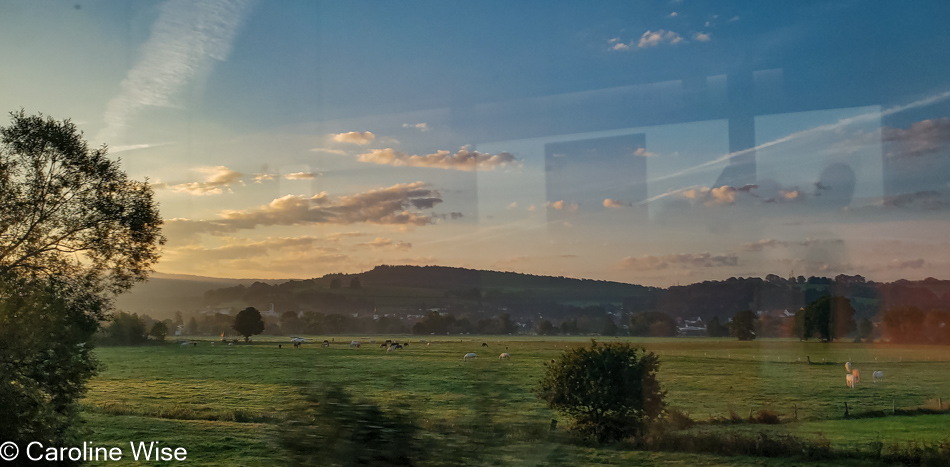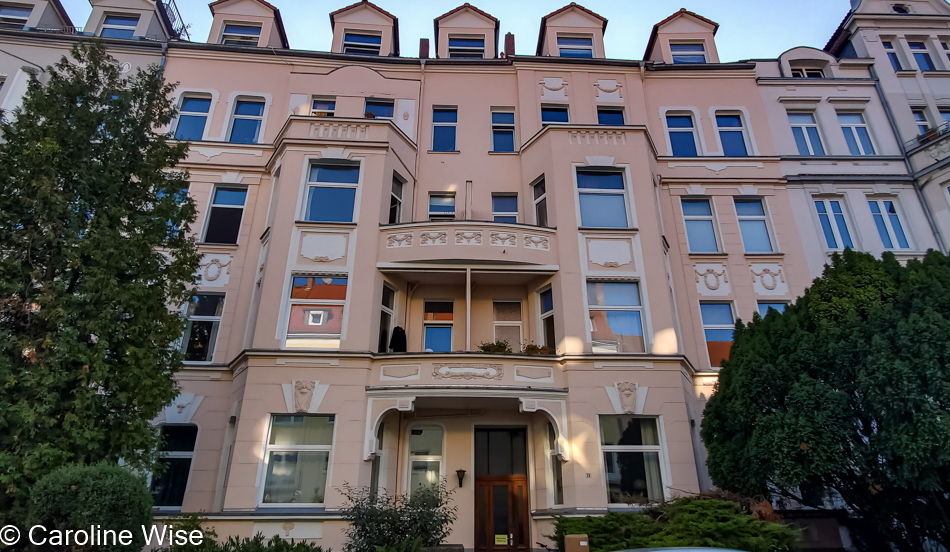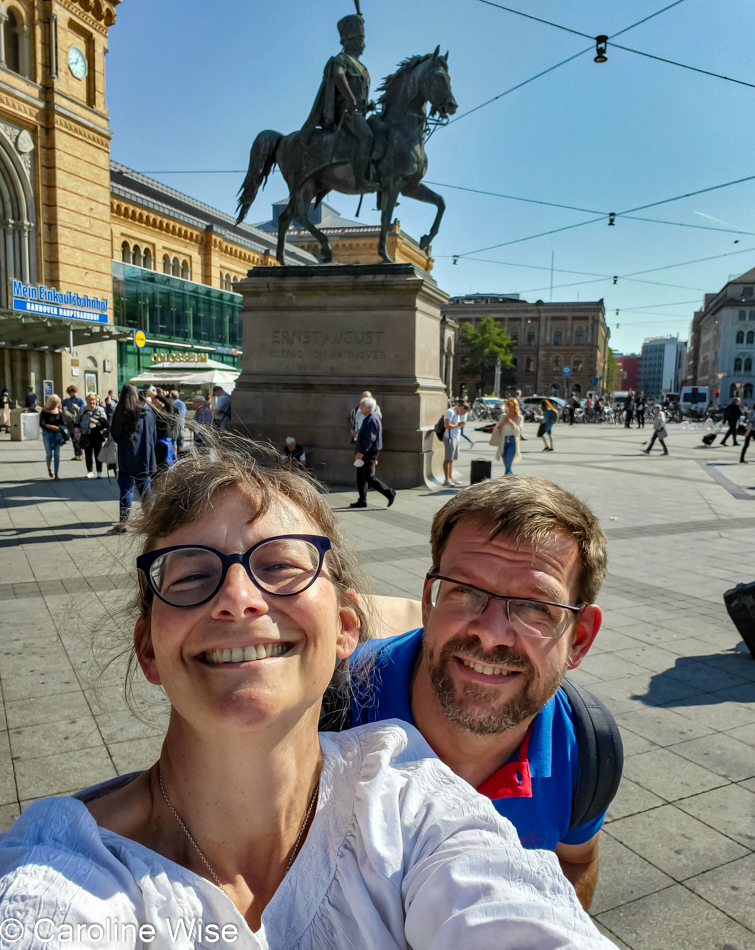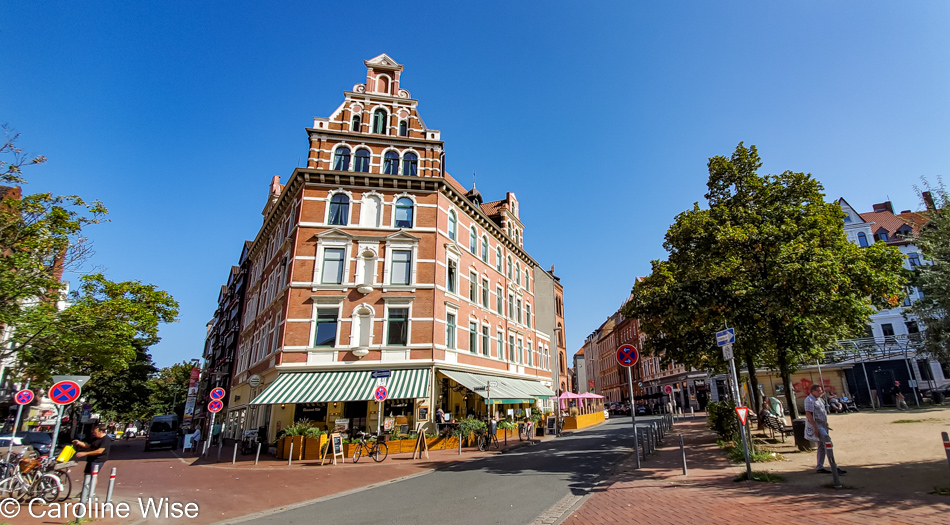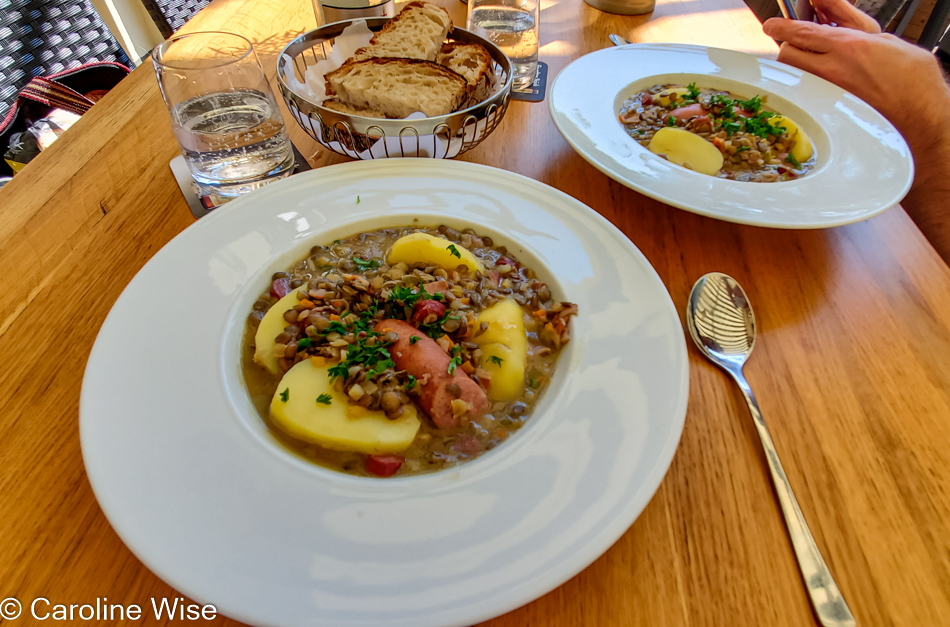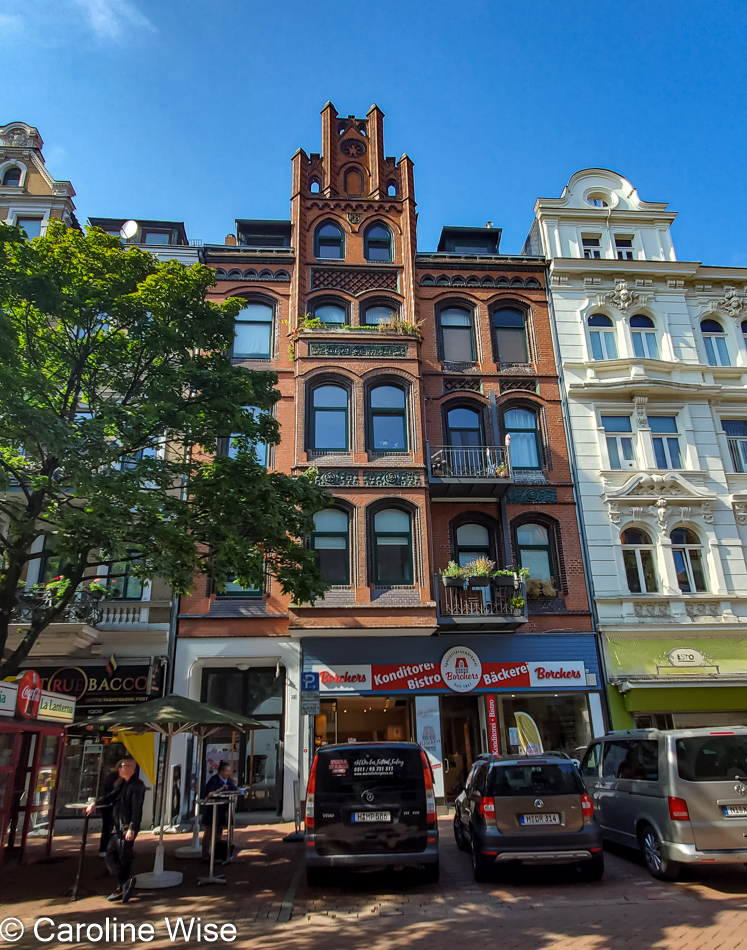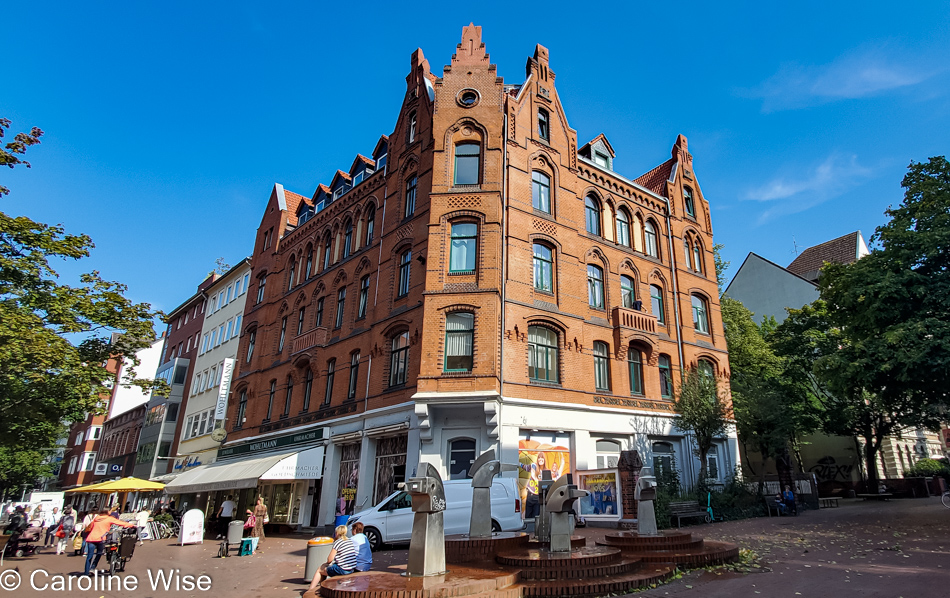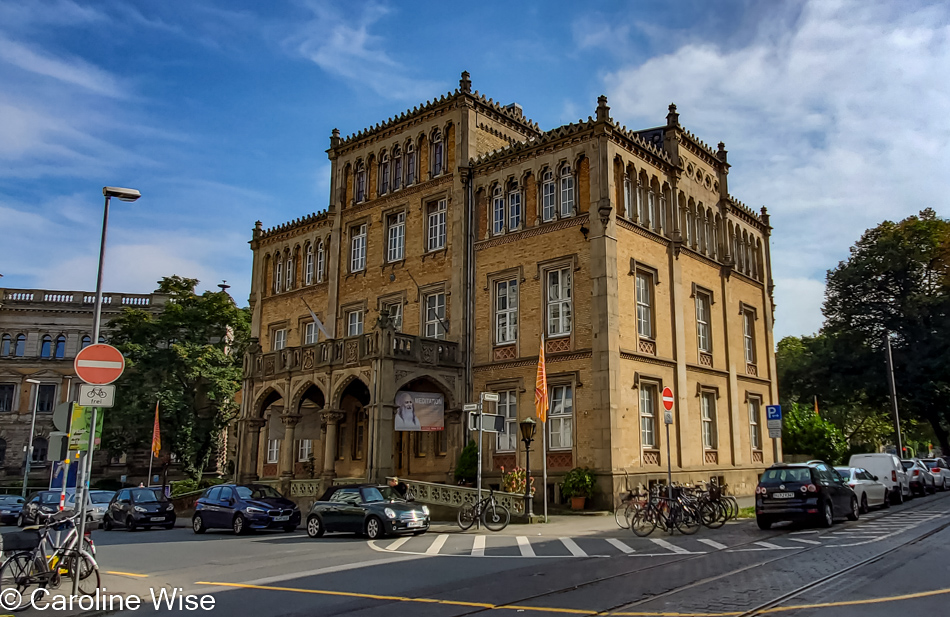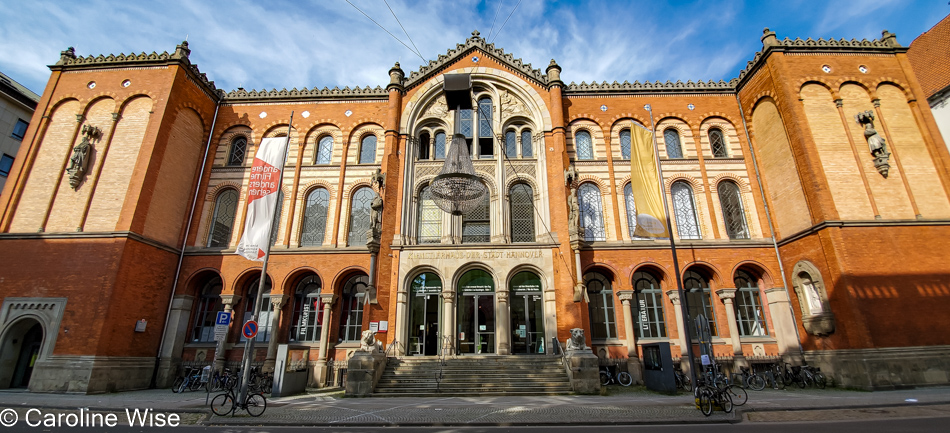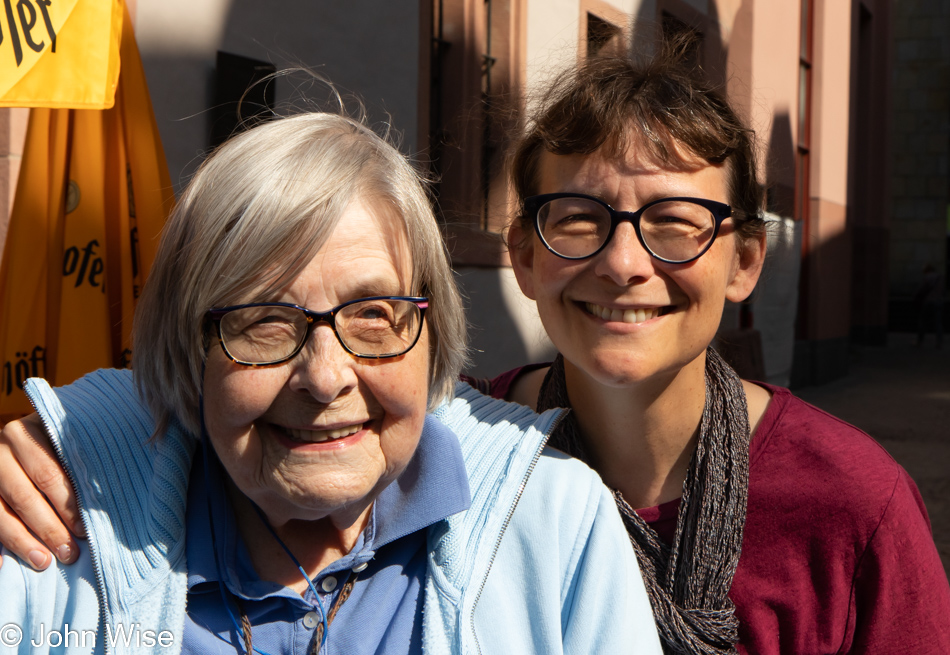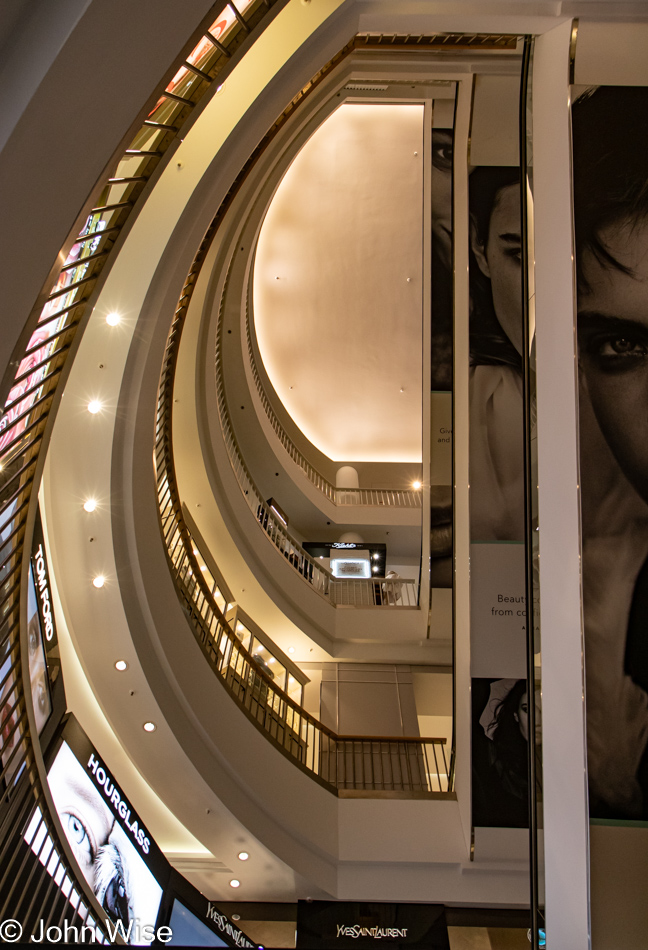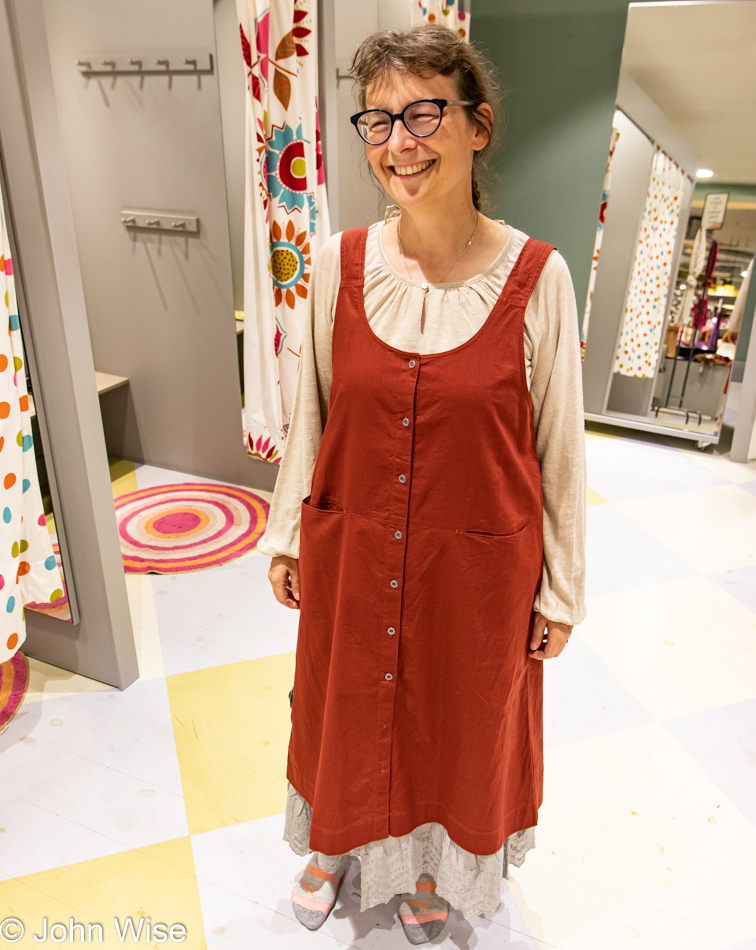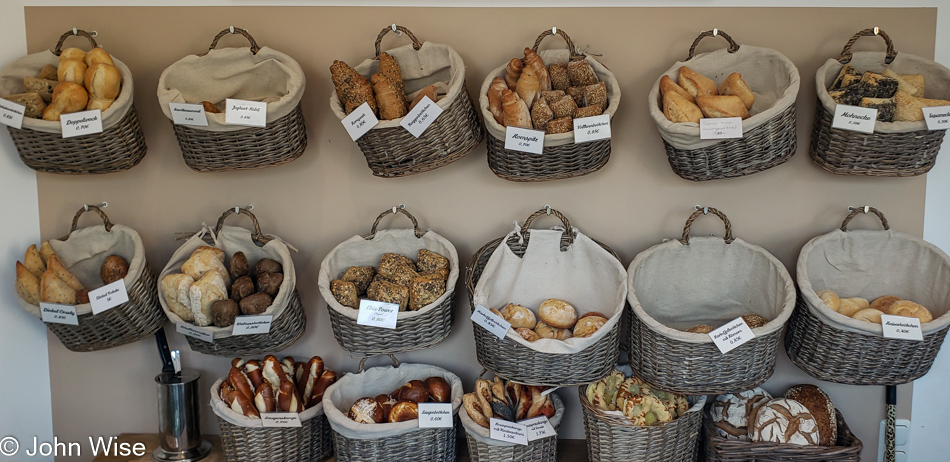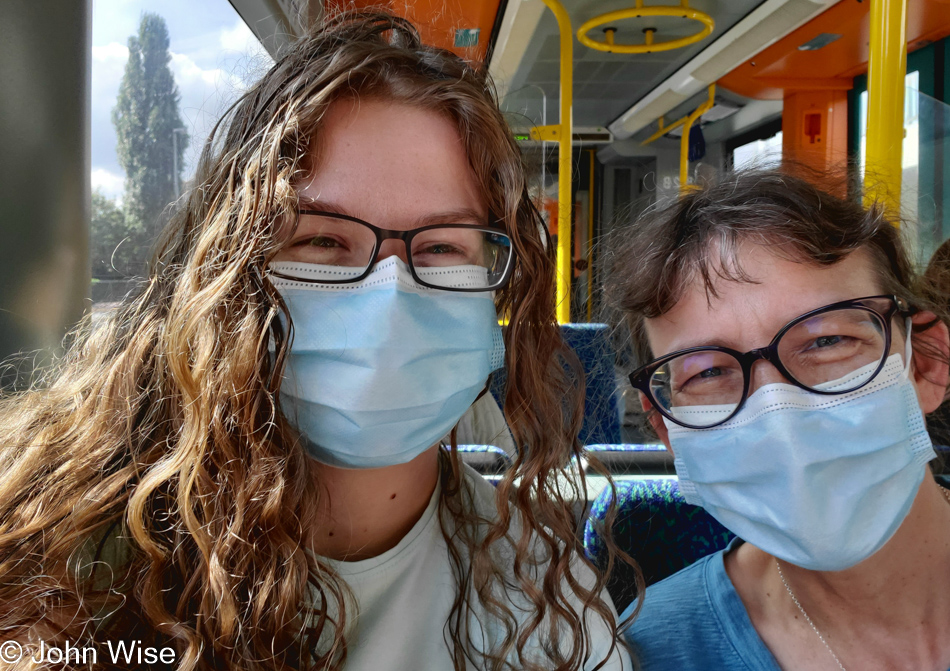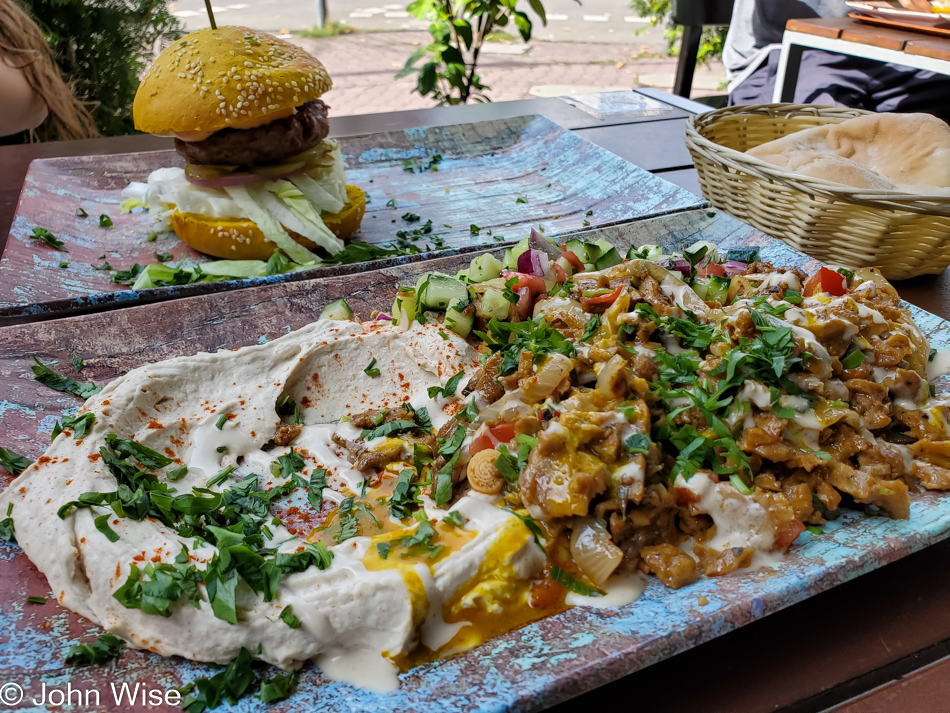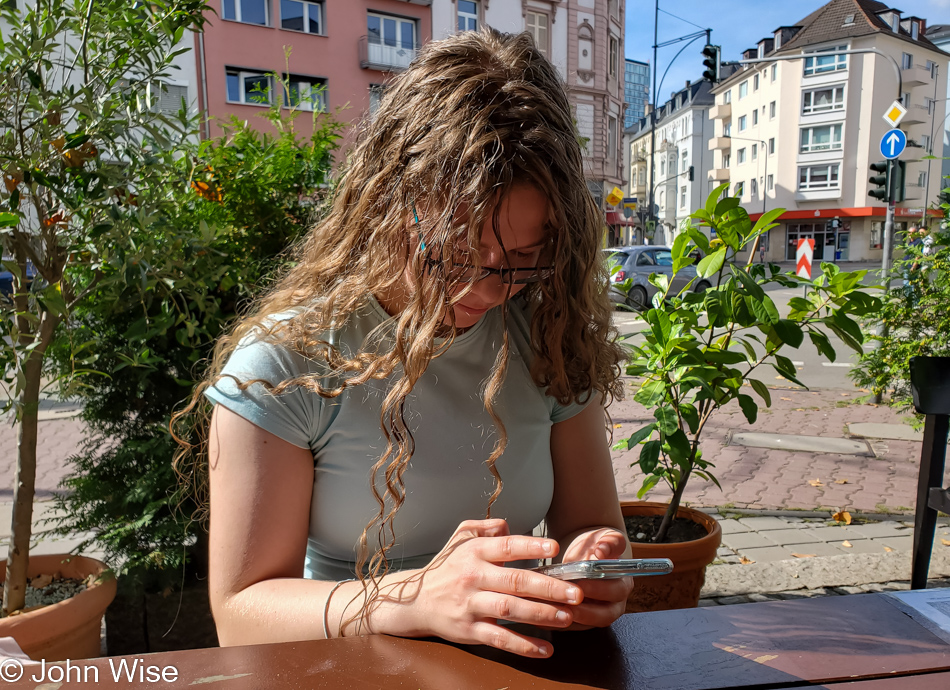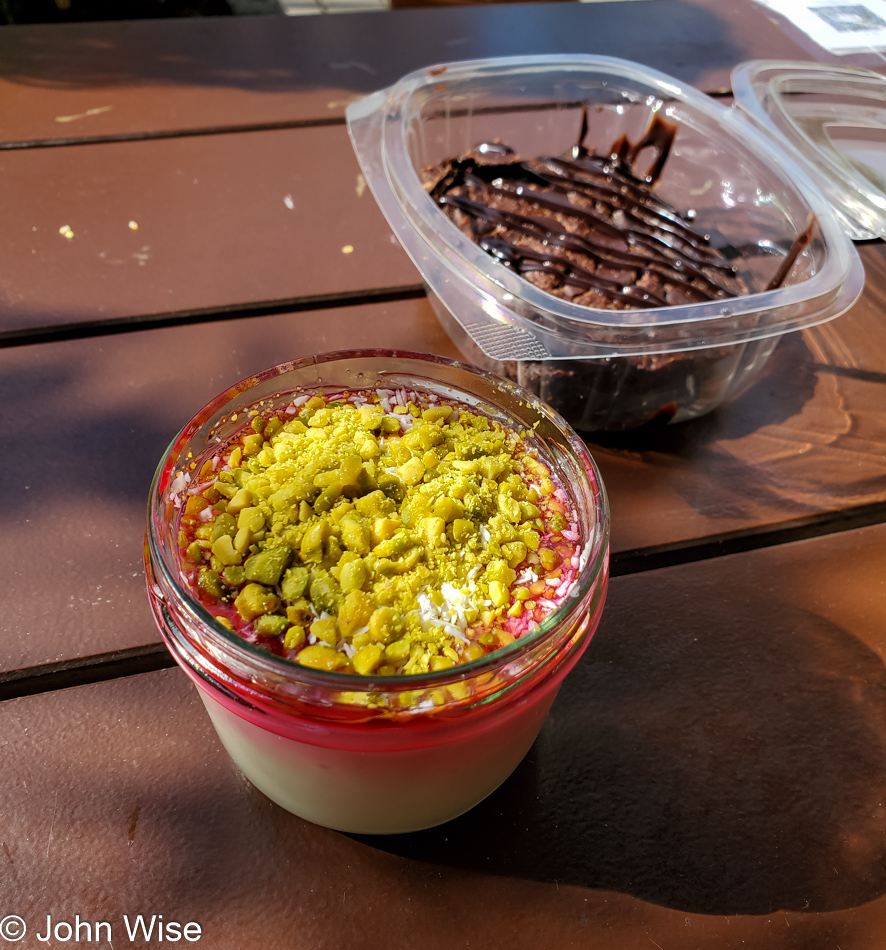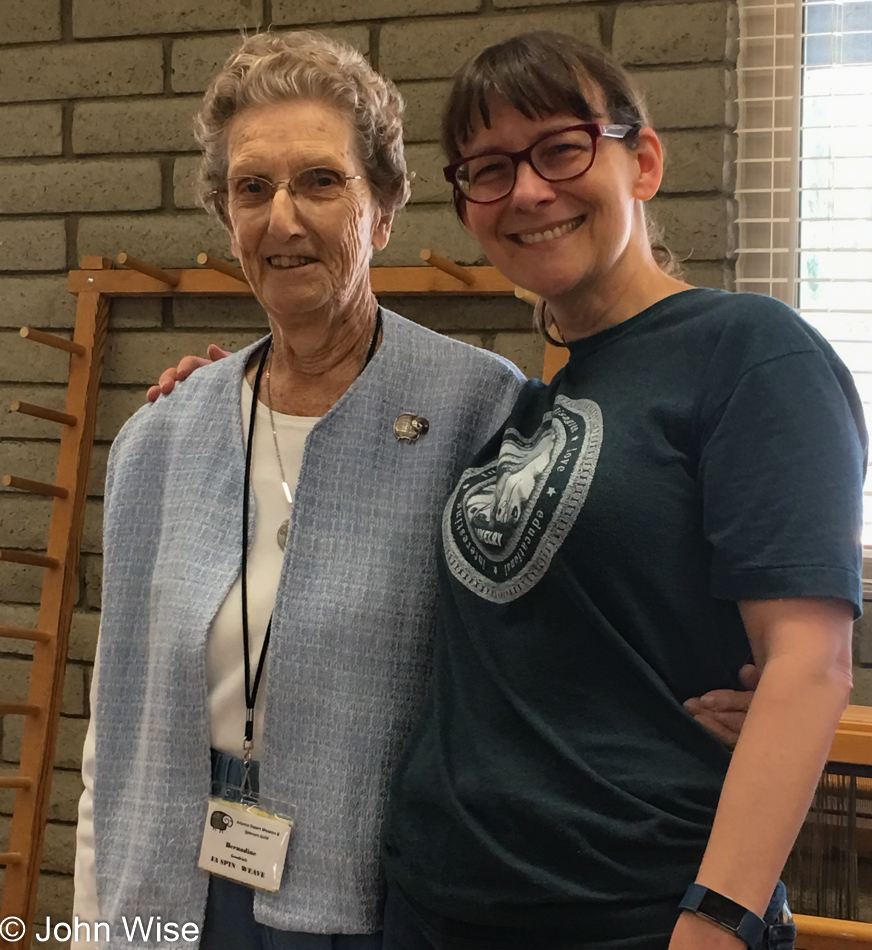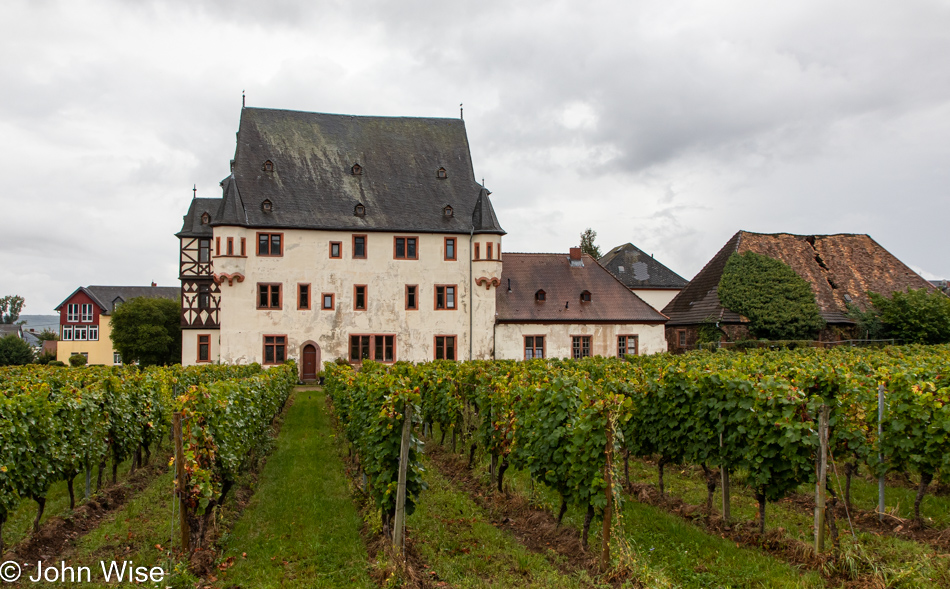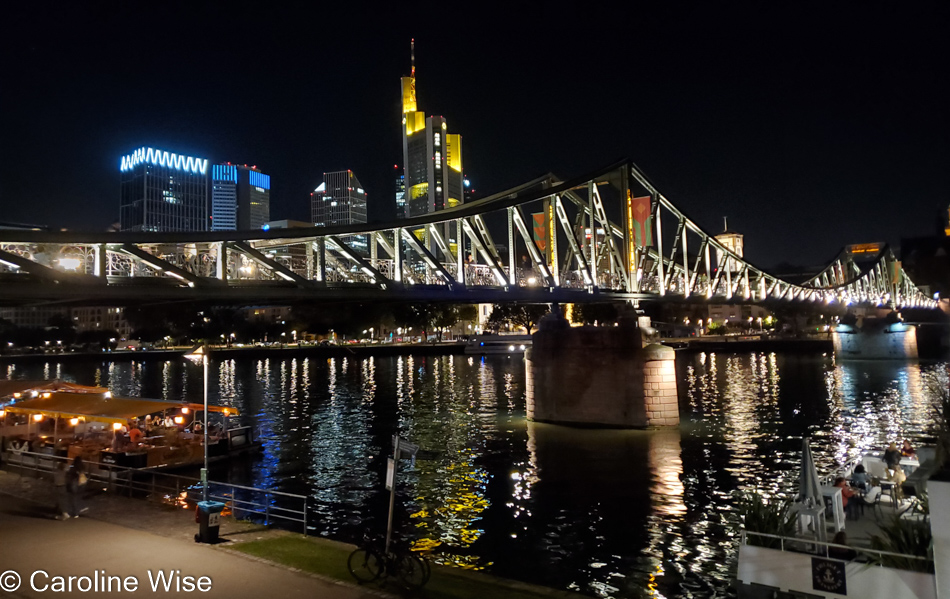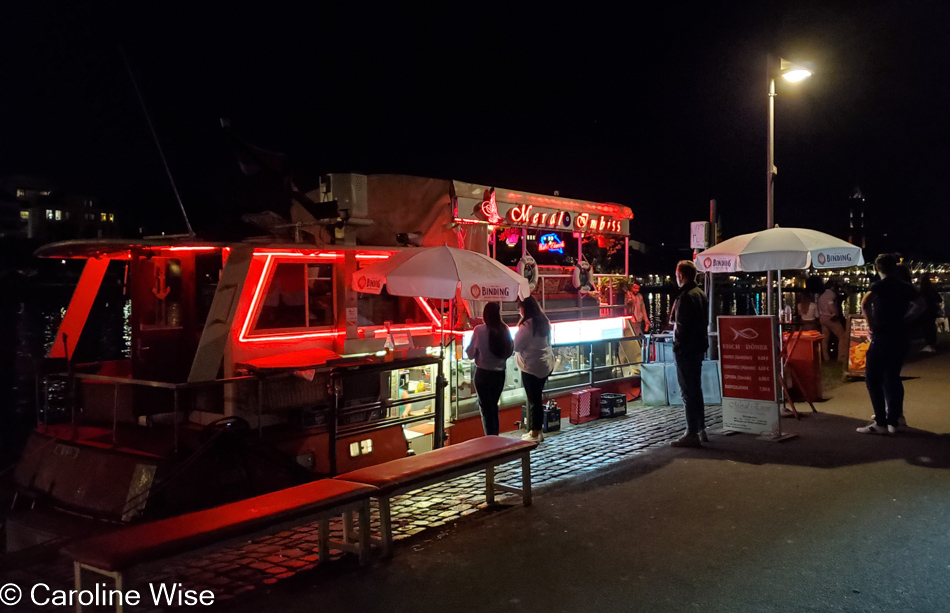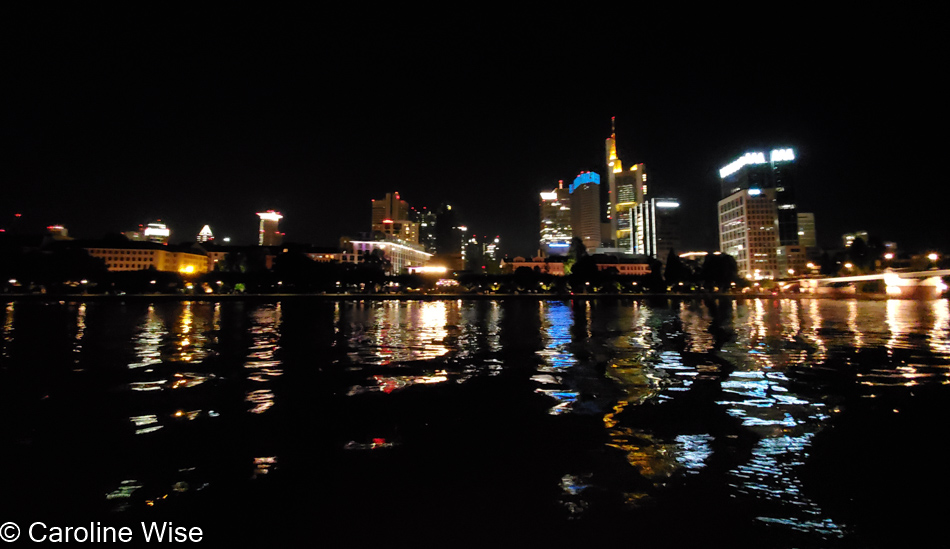
While Katharina and Caroline are spending a day together, I’m using the sun and nice weather to take a walk around Frankfurt. Be forewarned here that this blog entry is going to be a lengthy post due to the inclusion of 60 photographs taken along the path I walked. Even if I should go lightly on the text, you have a lot of scrolling ahead of you.
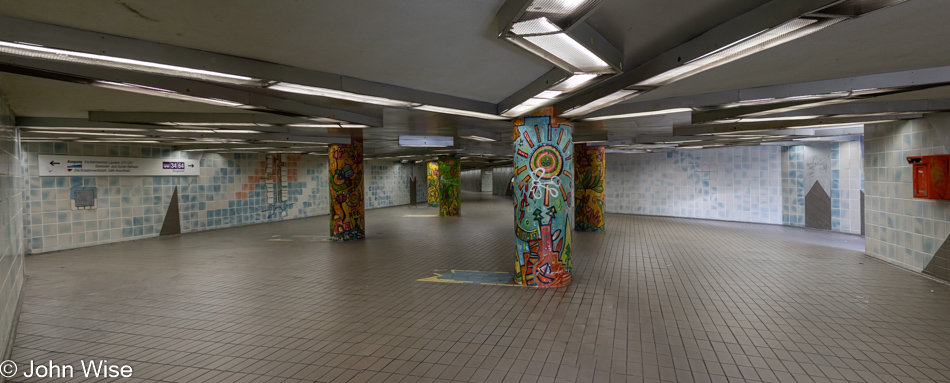
Before I got on the U-Bahn at Zeilweg, I studied the train map and was considering heading to an outlying town or even jumping on a train to Koblenz, but at the last second, I decided for this large circle around Frankfurt to see even more of the city I lived in for years and in some ways hardly knew. I exited at the Dornbusch stop and needed to head underground below the street in order to find my way to the part of the intersection that was going to be my starting point.

From Eschersheimer Landstrasse and Dornbusch, I turned to the west, and I was soon on Wilhelm-Epstein Strasse in the direction of Ginnheimer Landstrasse. I’ve not zoomed in far enough into the map to know yet where I’ll turn, but somewhere out there, I’ll continue my walk south until I cross the Main River before turning east and figuring things out once I make it that far. To the north, some heavy rain clouds loom, but I’m hoping they remain out there or dissipate over the course of the day. On with my walk…

As I said, the weather is on my side so far. I’m not looking to photograph monuments or even unique views from various points around the city but only share some of its character as seen on a continuous trek, taking a wide berth around the city center.

Mundane things like the sidewalk are shared as I often fail to capture these unique footpaths that are typically so very different than their American counterparts.
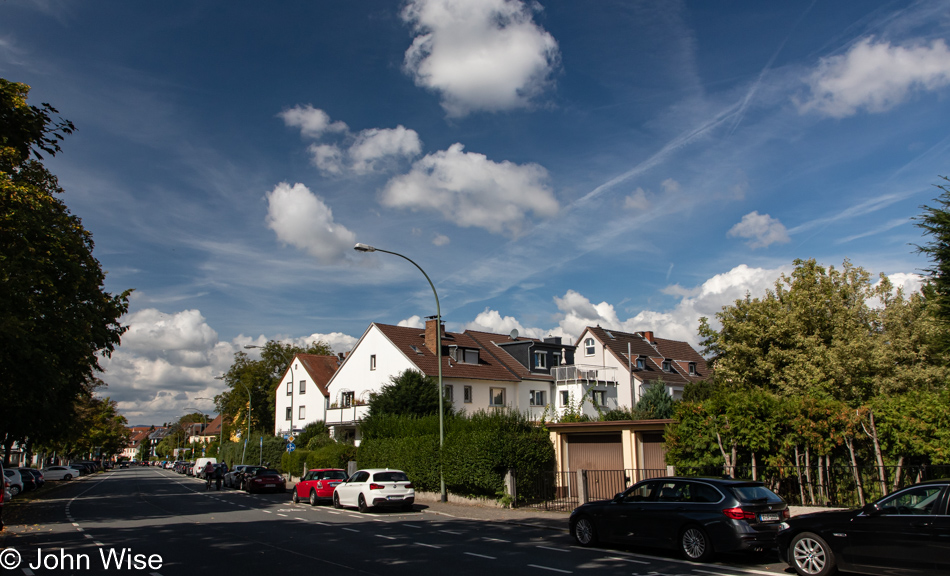
Residential neighborhoods often change quickly and can have a very different character, even from one side of the street to the other.

Frankfurt has integrated a judicious amount of green space into the layout of the city, making walking all the more pleasant. On my left and over the short wall nearly out of sight is the Bockenheimer Friedhof (Cemetery), where I’m turning south.
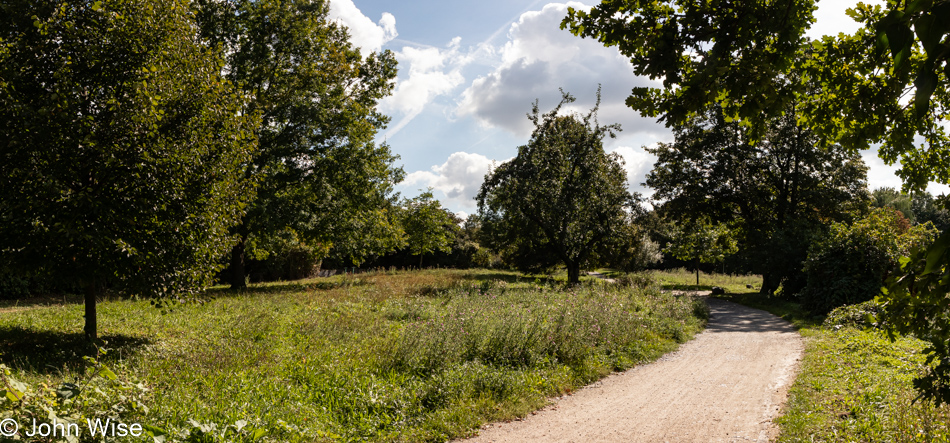
There are so many pathways crisscrossing Frankfurt where, for a time you leave the big city of business and banking.
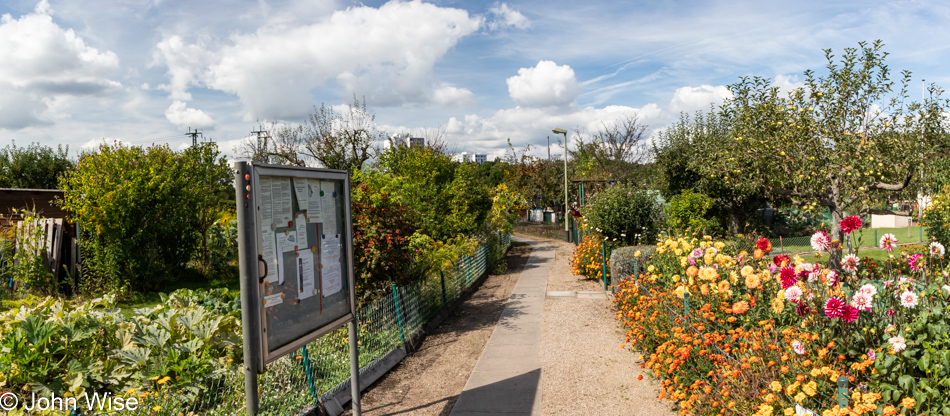
Skirting a cemetery on one side and small garden plots (the formal name is Kleingarten) seen across Frankfurt, I stop for a photo of a garden when a very friendly older man offers to open the gate for me to grab some better photos. I was surprised at the gesture and need to put that in the column of “Germany Improving For The Better!”

Sure, there’s a lot of ugly graffiti scrawled across Frankfurt am Main (Frankfurt on the Main River), especially the scribbles and curses on apartment buildings, but there is also some beautiful work that is often allowed to stand a good long while before some knucklehead comes along and disrespects it. [I did some follow-up on this mural, and it turns out that Helga Wally, pictured above, was a deeply respected and trusted person in the Frankfurt street art scene. She passed away in 2019, and this is her memorial – Caroline]
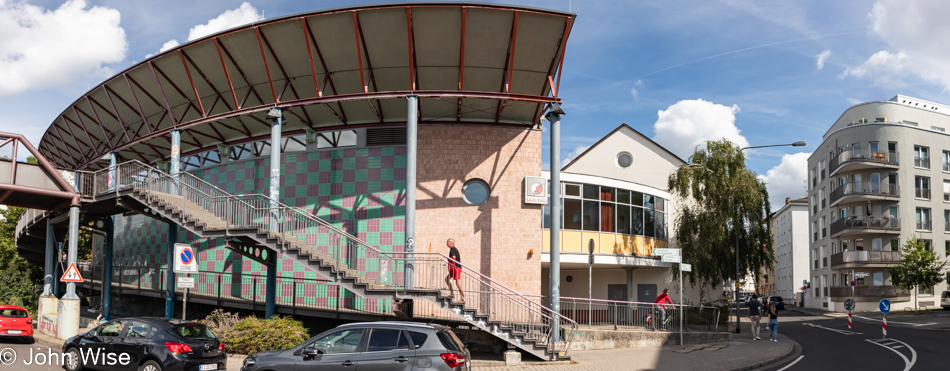
By this time I’ve been walking along some train tracks for a while now.

There’s a certain fluidity of economic status sprinkled across this city, and while there are pockets of incredible wealth, there are also diamonds in places you’d never suspect. At first blush, the casual visitor might not recognize the diversity of architectural treasures in Frankfurt, ranging from the Fachwerk (Half-Timber) of Römerberg to the high-rises (nearly unique to Europe), it’s easy to be overwhelmed by the big picture. Getting out on foot or by bike, one can peer into the tiny corners of this city.

This is the train stop for Frankfurt am Main West that I traveled to often when Caroline and I had an office nearby on Volta Strasse.
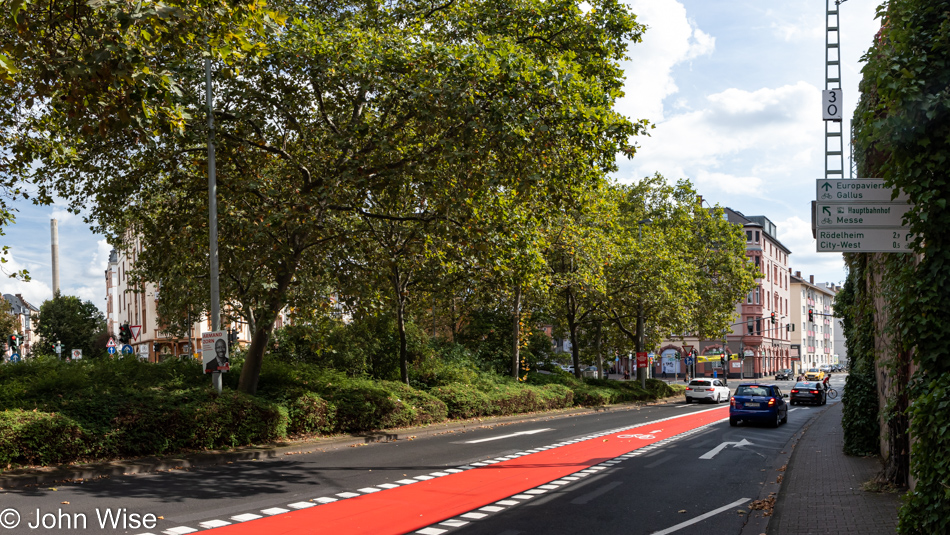
Keeping Google Maps open on my phone is eating my battery, so I’m reluctant to do any serious route searching that would keep me in green areas; plus, I wanted my walk to represent some of the many facets of this city. So, on occasion, I’m walking along larger roads or on narrow sidewalks I’d prefer to avoid, but this is the only way to share a diversity of views I suppose.

I can no longer remember the street name, or if this is the main road that connects to the A3 Autobahn as it’s been far too long since I drove these streets regularly, but if my memory isn’t betraying me, that’s exactly what this thoroughfare is doing.

This area through Gallus just south of Messe is the work of a massive undertaking where Frankfurt reclaimed railyards in order to build an entirely new area of apartments, offices, and shops that stretched behind me and over to the highrise in front of me.

Around the West End of Gallus, I end up at the intersection of Hufnagelstrasse and Mainzer Landstrasse for lunch at another location of the Turkish restaurant Central Grill. I’ve ordered a Tantuni Teller based on a photo that looks like something I’ve never tried before. Chopped meat, tomato, parsley, and onions wrapped in something a bit thicker than a tortilla covered in a yogurt sauce with a side of spicy peppers and a couple of wedges of lemon, lecker (yummy).

This is the old gate tower in Galluswarte that once helped control traffic in and out of the old walled city of Frankfurt. The gate tower in my head that directs writing has to multitask at times like this when I’m actually writing this paragraph on the morning of September 14, two days after I embarked on this walking tour. Earlier, on this day in the future, when this is being penned, I was writing of the events of September 11 as we were leaving Geisenheim. I’d finished it before arriving in Marburg, where I was going to spend the first part of the day, but that became a boondoggle you can read about two days from now and so I wrote a bit about that failed adventure before turning to this post which is far from done. But enough of this half-hearted lament, let’s return to the walk around Frankfurt.

This stretch of road feels bleak. Maybe it’s from being below things, or maybe it’s the industrialesque environment near the rail lines that run nearby?

On bicycles and scooters, you see a lot of people with Wolt and Lieferando boxes on their backs as they race around delivering food.

There’s more to the story here than meets the eye. Yes, this is a blackberry, and yes, I ate it, but this wasn’t where I wanted to be. I took a path hoping there’d be a trail where I wanted it to be, but fate would have it that I found a dead end. It didn’t have to be, but I’m 58 years old, and crossing four rail lines and hopping a fence to reach the pedestrian side of a rail bridge didn’t seem like the brightest of ideas and telling others that in old age, we should be cultivating no small amount of wisdom seemed to fly in the face of my advice.

So I turned around and took the proper trail down under a bridge and over to the other side where I could practice adulting.

It’s strange how someone can live in a city for years and never have crawled over a fraction of the places that are available to touch upon. From all the years I lived in the area to our multiple visits here in the intervening years we’ve been calling Arizona home, I’ve never walked over the rail bridge on the west side of Frankfurt. By the way, back when I was in my 20s, I never gave a second thought to running over the tracks and flirting with death, though I was pretty conservative as to when exactly I’d make a run for it.
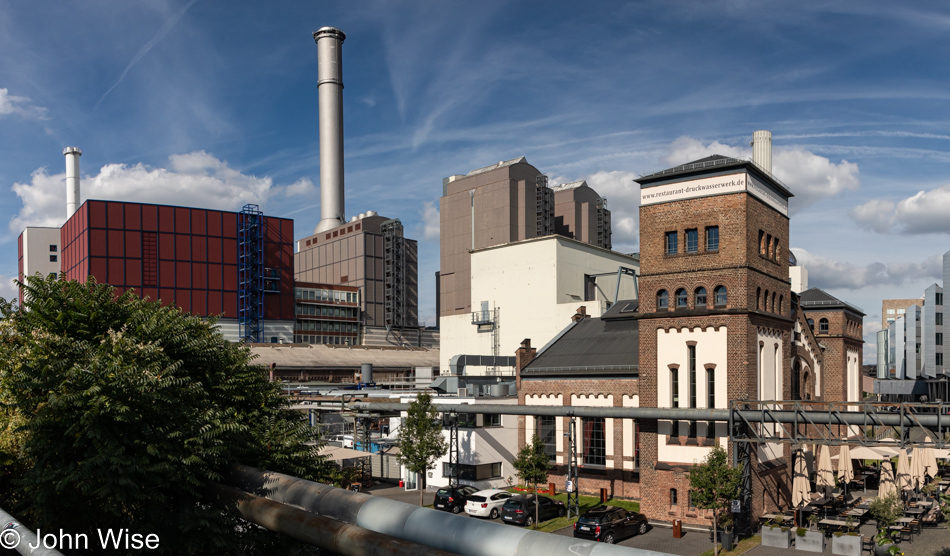
This area near the main power plant for Frankfurt has undergone a dramatic transformation since we left the city in 1995 and has seen some high-scale upgrades along the river with million-dollar apartments the rule.

Millionaire or pauper, everyone has access and the need to travel the same pathways through the city.
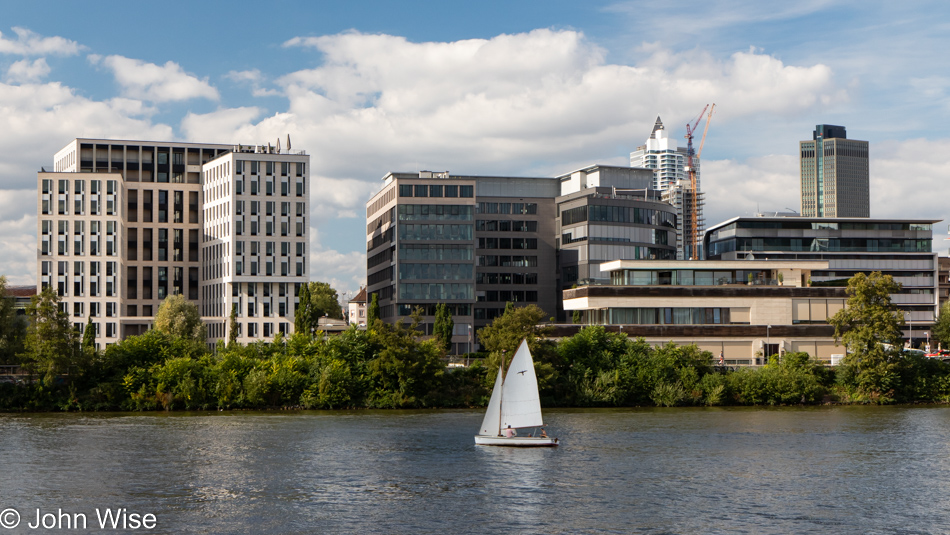
It’s not every day you see a sailboat on the Main River.

I had to skirt the bulwark of a university hospital that runs next to the river before turning south in Sachsenhausen.
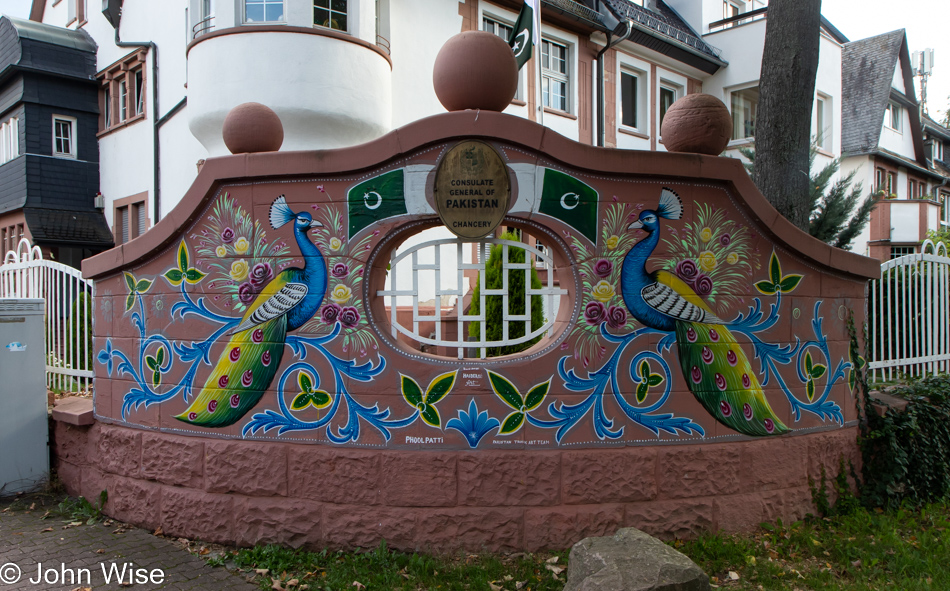
Another new find on my exploration of streets never walked before, there are more than a few consulates in this area, this one being Pakistan’s.

Don’t want to forget the small things as I focus on the bigger ones.

There’s a line drawn between high-rise apartments that are desired and those that must be avoided. All too often, these midrise addresses are relegated to affordable housing that, just as in all cities, draws in some unfortunate souls, often prone to aggression due to their limited intellectual capacities to see a future. Shit parenting is the same everywhere.

Besides being a haven for an incredible number of bees, this bush-covered multi-story tower of dubious utility belongs to a Korean church; nothing else is known.

Try to find food growing wild in America, other than blueberries in Maine and some rare berry finds in California and Oregon; we’ve been hard-pressed in our efforts to sample free things across the United States. Here in Germany, outside of traveling by car, we are stumbling across berries, apples, apricots, and now chestnuts [Sorry, John, these are an ornamental variety. – Caroline].

While I know that my entire walk will have come in just over 24 kilometers (roughly 15 miles), I don’t know where I was in that distance at this point. I’ve been on Mörfelder Landstrasse for a while now, that much I know.

Two people, age unknown, are memorialized here after they died back on February 13 of this year. I can only imagine they were trying to cross this major thoroughfare and that someone traveling way too fast didn’t see them. A sad and tragic moment along my walk.

Street trams are known by numbers such as this one numbered 18, as opposed to U-Bahns that run underground and above ground but have a “U” designation before their number.

Visiting a friend? You’ll have to find their name on one of the buttons and press it to buzz them, and then they can unlock the door from their apartment and let you in. Most of these apartments that are less than six floors do not have elevators so tenants and visitors often get a good amount of stair climbing in per day. Add to those stairs that the train system also features platforms that require people to scale heights and climb down into the depths of subways so legs are always getting a good workout.
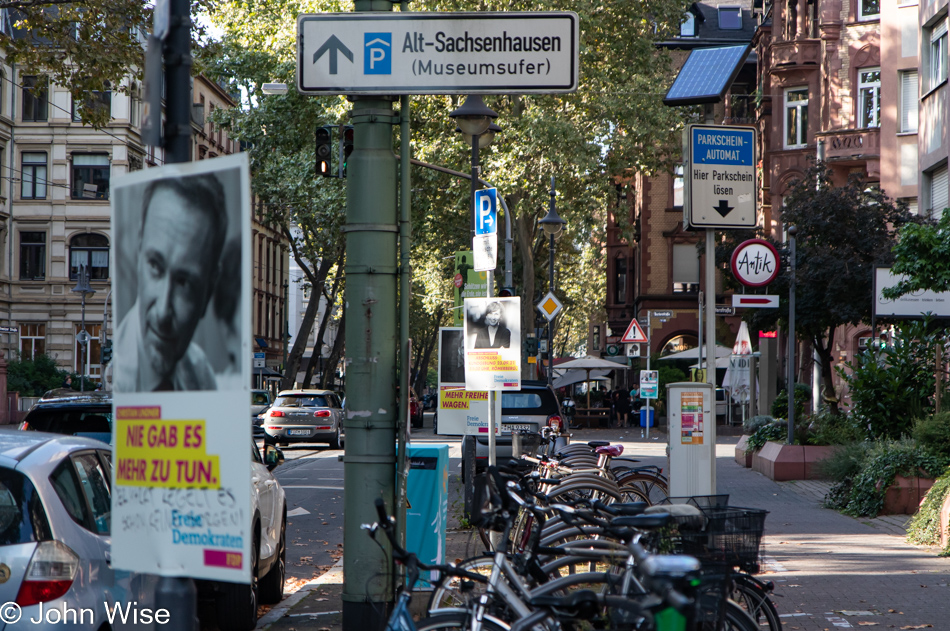
While much of central Frankfurt north of the Main River was destroyed in World War II, I have the impression that a lot of Old Sachsenhausen remained intact. Maybe this is due to the area being permanently drunk, such as the man who’s drunk himself into such a pickled state that when he falls down, he simply bounces a while before settling into his stupor. Yep, I am suggesting this part of the city is that inebriated.

If this is postwar architecture and I was wrong about Sachsenhausen, or this was all rebuilt, we’ll let Caroline weigh in on the matter. [Definitely not postwar, John – Caroline]

Let me not forget that shopping is distributed throughout Frankfurt; even in residential areas, there are small shops here and there or, at a minimum, a small kiosk, which is a small convenience store.
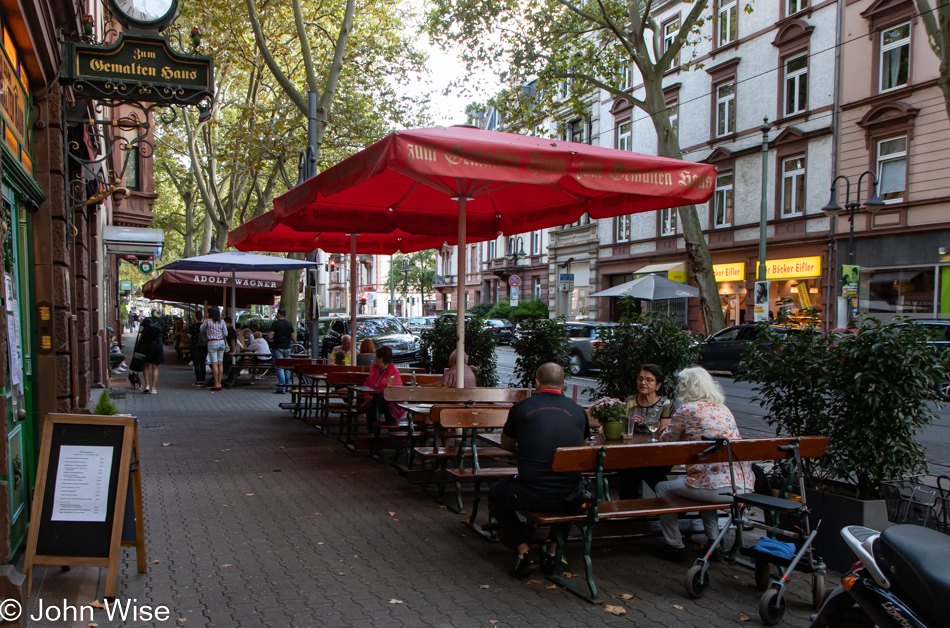
Spring, summer, and early fall streetside dining is often an option in Germany especially these days of the pandemic. There’s one downside of eating out in the fresh air: it’s not fresh as Germany hasn’t given up smoking in areas where people eat. It’s not uncommon for four people at the next table to light up just as your food is being delivered. Back when we lived here, people smoked everywhere except on trains, and even that wasn’t always observed.

Of course, there’s no need for anyone else to walk 24 kilometers around a city as with so many options to get to where one wants to get, Germany is nothing if not convenient for options. From car-sharing, scooters, bike rentals, subways, trams, taxis, inter-city trains, and, of course, feet, it’s easy to travel these lands.
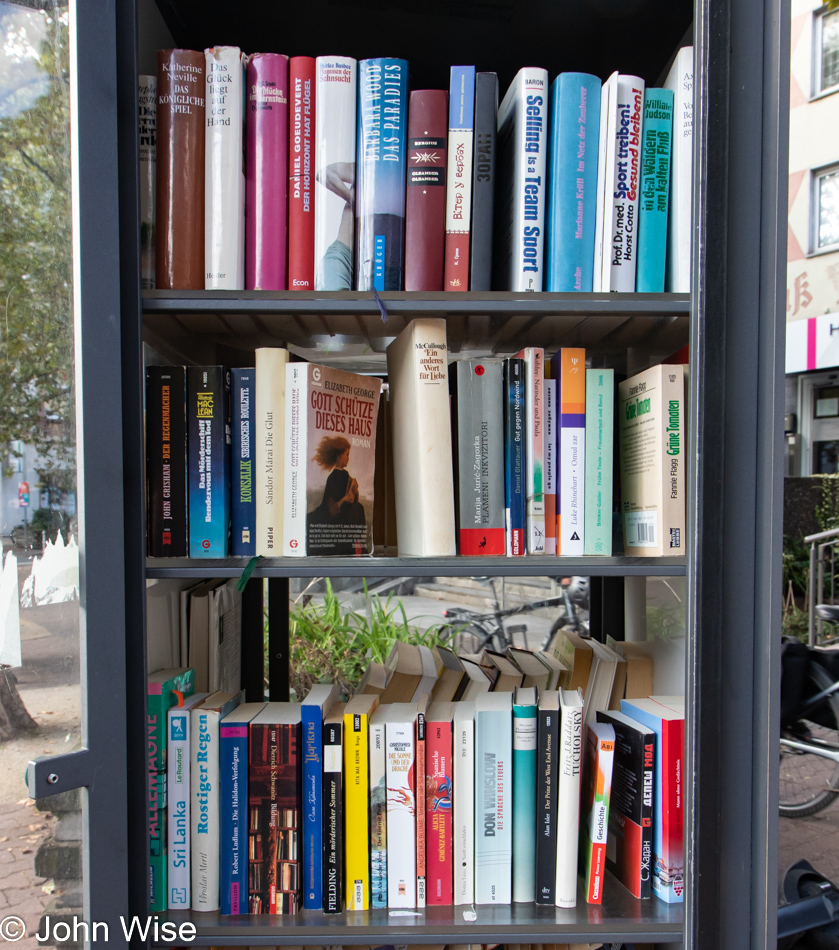
Need a free book? Small libraries packed with donations from people in the neighborhood are hosted across the region. I’m not sure Germany’s Little Free Library is part of that system, but it’s effectively the same thing.
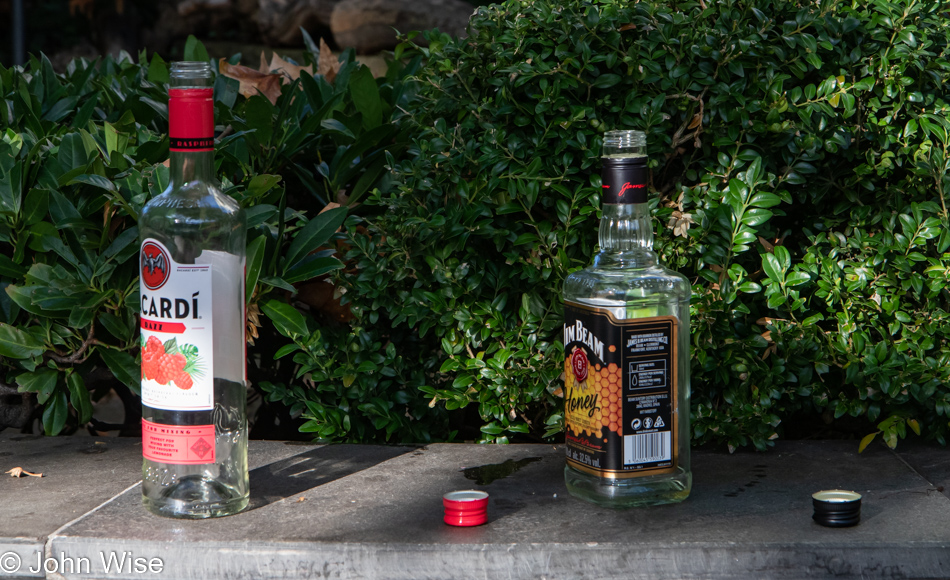
On a Sunday morning, you’ll see a lot of evidence of the festivities held the night before. It’s quite common to see young people walking around with open bottles of alcohol, getting tipsy as they stride into the night. The next day, empty bottles and broken glasses litter the landscape.

I’m losing steam as I reapproach the Main River. Caroline and Katharina are done visiting Jutta, and while Katharina needs to head back to Darmstadt, Caroline and I are going to meet for dinner.

With Caroline coming from Römer and where I was on Schweizer Strasse, it made sense to meet in the middle.

That middle was on Eisener Steg over the Main River.

Our dinner date was at Apfelwein-Wirtschaft Fichtekränzi in Sachsenhausen; not the first time we’ve eaten here.

I’m tired but not willing to call it quits yet; I’m going to drive on with our path going by Eis Christina as I’m drawn in by the promise of my favorite spaghetti eis.

Can you smell the reek of piss and beer? They call that Old Sachsenhausen.
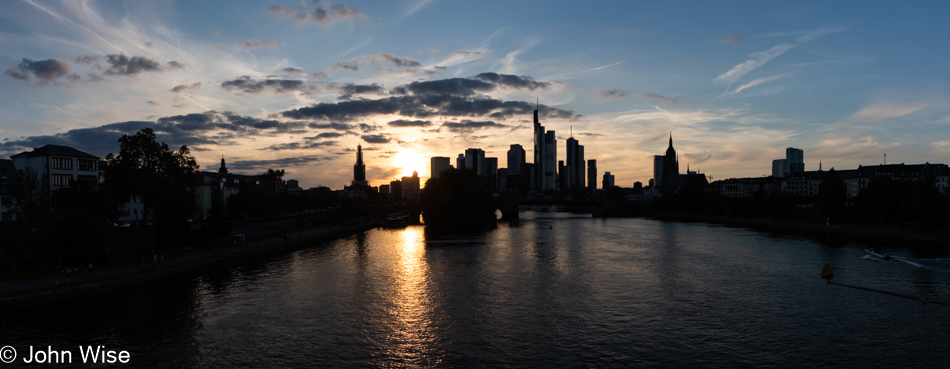
Back over the Main River with a view we never tire of, sunset over Frankfurt.

I’ve seen a lot of things on the street, but never a growling, unintelligible woman living in a cage. I thought I’d be stealthy and zip around the front of her after walking behind the sidewalk-blocking enclosure so I could snap a photo of the creature that lives within but she was having none of it. Armed with a sharpened stick, she gave me the finger and raised her weapon; I thought better of my naive move and retreated as I wasn’t in the mood to risk losing a testicle.

No part of some stinking Democratic or Republican party, Flora Gessner is full-on part of the Pirate party and is running for office, taking no prisoners.

Ooh, my lucky day as the yarn store is closed, but hey Caroline, at least you have this photo of what you couldn’t buy.
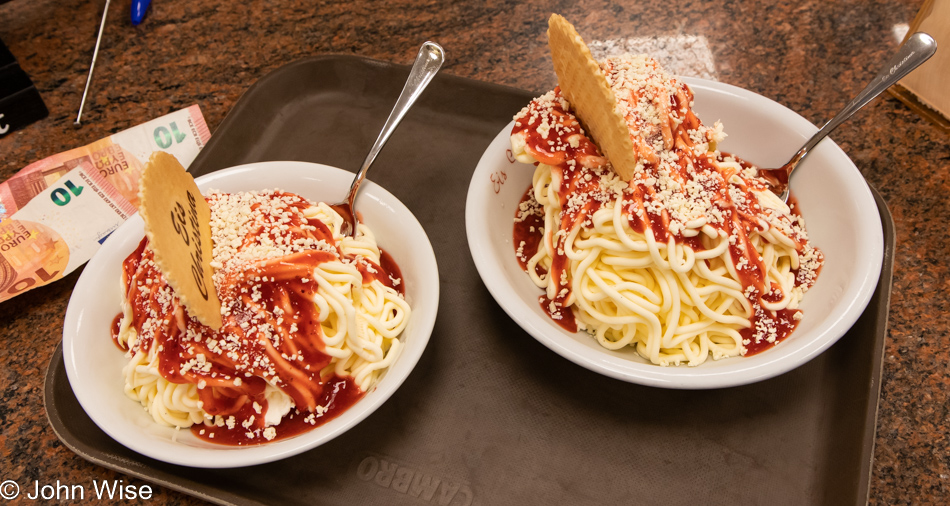
Oh yeah, spaghetti eis a.k.a. vanilla ice cream pressed through a spaetzle doohickey onto a layer of whipped cream and topped with strawberry sauce and parmesan cheese, I mean white chocolate pieces. I can’t tell you why the appearance of spaghetti makes this better, but it does.

Sure, there was a temptation by now to jump on this train and speed our way to Dornbusch, but with so little to go on my long walk around Frankfurt, I’m not about to quit now.
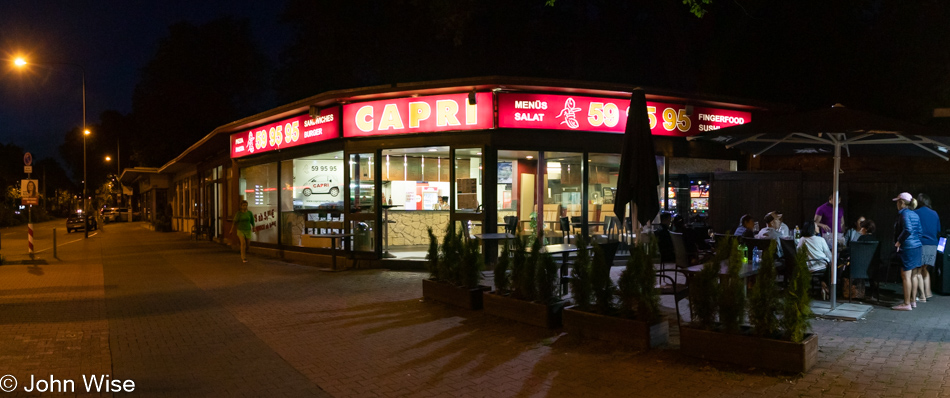
When I first arrived in Germany in 1985, the American Post Exchange, or PX, was just down the street from here. While the U.S. military presence is long gone, Capri Pizza soldiers on. Serving burgers, pizza, and more, it’s been here so long that the phone number on the sign reflects an age gone by as it’s listed as 59 95 95. Those days are gone, and from the recent reviews of Capri, they should be gone, too.

Across the street from here is the Hauptfriedhof, or main cemetery. I’ve never visited it and won’t find the time to do so on this trip unless we scale the wall here late in the evening.

Meet Onkel Otto wearing his mask to lend weight to the need for Germans in the Hessen area to wear theirs. Uncle Otto is the mascot or was the mascot for Hessischer Rundfunk (Hessen TV).

And here we are where I started earlier today, having made a full circle. With almost 32,000 steps, 24 kilometers (15 miles), and more than 6 hours of registered activity on my Fitbit, this was my view of Frankfurt.
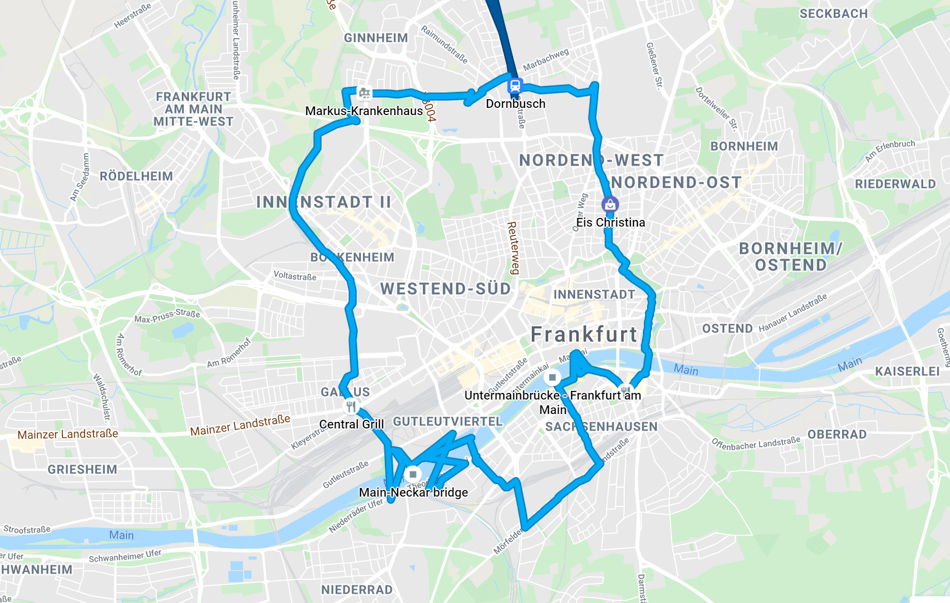
If you’d have asked me 30 years ago if this were possible, I would have thought absolutely not. In my perception of Frankfurt, it was as big as Los Angeles or any large city I’d been in, but the truth is that density, architecture, and street size deceive the naive mind. This opens up the crazy idea that the 34 days needed to walk from Flensburg in the north to the southernmost German town of Sonthofen could be a possibility.
